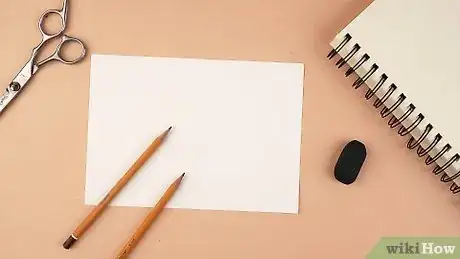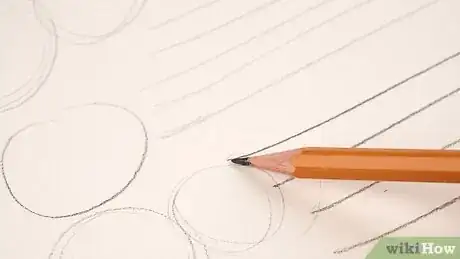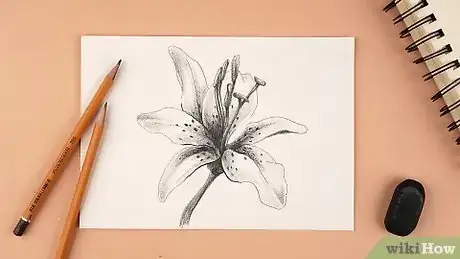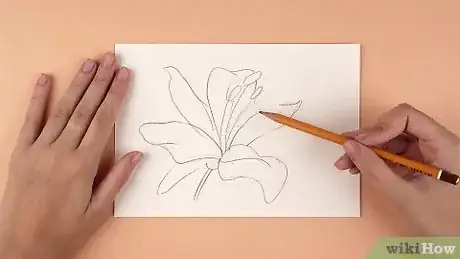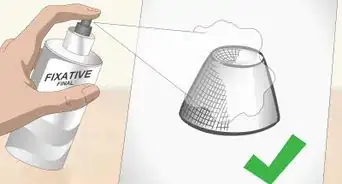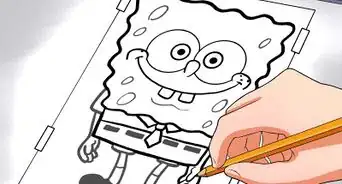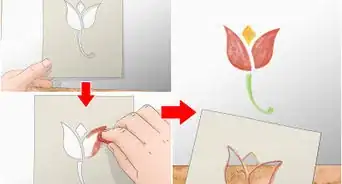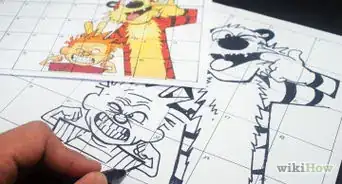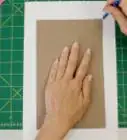This article was co-authored by Kelly Medford. Kelly Medford is an American painter based in Rome, Italy. She studied classical painting, drawing and printmaking both in the U.S. and in Italy. She works primarily en plein air on the streets of Rome, and also travels for private international collectors on commission. She founded Sketching Rome Tours in 2012 where she teaches sketchbook journaling to visitors of Rome. Kelly is a graduate of the Florence Academy of Art.
wikiHow marks an article as reader-approved once it receives enough positive feedback. This article received 18 testimonials and 83% of readers who voted found it helpful, earning it our reader-approved status.
This article has been viewed 1,092,605 times.
Sketching is the practice of drawing a rough outline or rough draft version of a final piece of art. Sketching can be used in preparation for a large piece of art, or to just get an idea of how something will look. Whether you're sketching for fun or for a project, learning the proper technique can make the practice much more enjoyable.
Steps
Practicing Sketching
-
1Get the right materials. Just like with any art form, it is difficult to sketch when using poor quality (or the wrong) materials. You can easily find all the proper sketching materials at a local arts and crafts store.[1] Spend a few dollars and gather up all the right materials, including:
- H pencils. H pencils are the hardest pencils, and are used for sketching thin, straight, non-blend-able lines. These are mostly used for architecture and business sketches. Get an assortment including 8H, 6H, 4H, and 2H pencils (8H is the hardest, 2H is the softest).
- B pencils. B pencils are the softest pencils, and are used for making smudged and blurry lines and for shading your sketch. These are the favorites of many artists. Get an assortment including 8B, 6B, 4B, and 2B (8B is the softest, 2B is the hardest).
- Fine art paper. Sketching on regular printer paper may be easy, but the paper is thin and doesn't hold the pencil as well. Use fine art paper with a bit of texture for the easiest time sketching, and for the best overall appearance.
-
2Practice some hand movements, before you start sketching. For example, you can draw circles or horizontal lines for five-ten minutes to warm up your hand.Advertisement
-
3Start with an H pencil. Use light strokes with loose hands. Move your hand very quickly, using minimal pressure, almost glossing over the page without stopping. Get comfortable with the paper you are working with. At this initial stage, you should barely be able to see the strokes. Consider this to be the foundation of your sketch.[2]
-
4Use the darker 6B pencil for the next stage. When you achieve the perfect shape in Step 3, you can then define your strokes more precisely with this darker pencil.[3] Keep adding details. Start adding inner shapes. Make sure they are to scale. For example, when drawing a parking ramp, you want to make sure that the entrances and parking spots are the appropriate size.
- When you are finished using this pencil, you will notice smudges on the pages since the lead on this pencil is softer than the previous one. Remove all smudges with the eraser.
- Make sure you use a soft eraser like the putty eraser so that your erasing does not rip off the top layer of the page. The putty eraser will lighten your lines, not completely eradicate them.
-
5Add further details. Perfect your lines and presentation until you are satisfied that you have captured the perfect representation.
-
6Seal your work. When you have completed your sketch, apply a fixative to seal the image.
- Use a mirror when drawing. Periodically, look at your drawing and the thing you are drawing in the mirror.
- Leonardo DaVinci did this and recommended it.
- It helps to see your drawing differently and note the mistakes.
Learning the Basics
-
1Try doing a gesture drawing. Gesture drawing is a form of sketching where you use continuous movements and connected lines to draw your subject, without ever looking at your paper. Although it sounds difficult, it can help you to get a good idea of the basic forms in your drawing, and help to set a base for your final drawing. To do a gesture drawing, look only at your subject and move your hand accordingly on the paper. When possible, avoid lifting your pencil and use overlapping lines. Later, you can go back and erase the extra lines and perfect your sketch.[4]
- This is good practice for a sketch - kind of like a pre-sketch.
-
2Don't press too heavily. A sketch is intended to be the base or draft of an image. Therefore, when you start your sketch you should use a light hand and lots of short, quick strokes. This will make it easier to test out different ways of drawing a particular object, and will allow you to erase mistakes much easier as well.
-
3Choose your subject. For beginners, it is easiest to sketch from a live model or an image, rather than by using your imagination to create an image to draw. Find an image of something you like, or look for an object or person around you to draw. Take several minutes to study the subject prior to beginning to sketch. Pay attention to these things:[5]
- Find the source of light. Locating the primary light source will determine where you sketch the lightest and where you sketch the darkest.
- Look for any movement. Whether actual movement from a real-life subject or perceived movement in an image, determining movement in your subject will determine the shape/direction you make your sketch strokes.
- Pay attention to primary shapes. All objects are made up of a combination of the basic shapes (square, circle, triangle, etc.). Look for the shapes that underlay your subject, and sketch these first.
Expert Q&A
-
QuestionWhat can you use to shade evenly with a pencil?
 Kelly MedfordKelly Medford is an American painter based in Rome, Italy. She studied classical painting, drawing and printmaking both in the U.S. and in Italy. She works primarily en plein air on the streets of Rome, and also travels for private international collectors on commission. She founded Sketching Rome Tours in 2012 where she teaches sketchbook journaling to visitors of Rome. Kelly is a graduate of the Florence Academy of Art.
Kelly MedfordKelly Medford is an American painter based in Rome, Italy. She studied classical painting, drawing and printmaking both in the U.S. and in Italy. She works primarily en plein air on the streets of Rome, and also travels for private international collectors on commission. She founded Sketching Rome Tours in 2012 where she teaches sketchbook journaling to visitors of Rome. Kelly is a graduate of the Florence Academy of Art.
Professional Artist You can use Prismacolor ebony pencils. They are very dark and smooth and great for shading evenly in pencil.
You can use Prismacolor ebony pencils. They are very dark and smooth and great for shading evenly in pencil. -
QuestionWhat is the best way to scale a drawing?
 Kelly MedfordKelly Medford is an American painter based in Rome, Italy. She studied classical painting, drawing and printmaking both in the U.S. and in Italy. She works primarily en plein air on the streets of Rome, and also travels for private international collectors on commission. She founded Sketching Rome Tours in 2012 where she teaches sketchbook journaling to visitors of Rome. Kelly is a graduate of the Florence Academy of Art.
Kelly MedfordKelly Medford is an American painter based in Rome, Italy. She studied classical painting, drawing and printmaking both in the U.S. and in Italy. She works primarily en plein air on the streets of Rome, and also travels for private international collectors on commission. She founded Sketching Rome Tours in 2012 where she teaches sketchbook journaling to visitors of Rome. Kelly is a graduate of the Florence Academy of Art.
Professional Artist You can buy a wheel that shows the ratios to scale a drawing. Then you will not have to do the calculations.
You can buy a wheel that shows the ratios to scale a drawing. Then you will not have to do the calculations. -
QuestionHow do I sketch real people's faces?
 Community AnswerUsually you would want to start with basic shapes, then put in details. Do it step-by-step until you think it looks good, and then erase any unnecessary lines from your starting sketch.
Community AnswerUsually you would want to start with basic shapes, then put in details. Do it step-by-step until you think it looks good, and then erase any unnecessary lines from your starting sketch.
Warnings
- Having a poorly lit space may cause eye strain. Make sure you have a well-lit, spacious area.⧼thumbs_response⧽
- Soft leaded pencils smudge easily. When you are not using them, keep them in a plastic container or bag for protection.⧼thumbs_response⧽
Things You'll Need
- Clean paper
- Something to sketch
- HB pencil
- 6 B pencil
- Clean hands
- Putty eraser
- Light
- Aerosol fixative (can be found in any art supply shops)
References
- ↑ http://www.learn-to-draw.com/drawing-basics/03-drawing-with-pencils.shtml
- ↑ https://greatondraftdesigns.com/what-number-pencil-to-use-for-sketching/
- ↑ https://greatondraftdesigns.com/what-number-pencil-to-use-for-sketching/
- ↑ https://conceptartempire.com/tips-for-gesture-drawing/
- ↑ http://www.learn-to-draw.com/drawing-basics/06-drawing-elements.shtml
About This Article
Before you start sketching, make sure to buy all the necessary materials for best results, including H pencils, B pencils, and fine art paper. Then, practice drawing circles or straight lines for 5-10 minutes to warm up your hand. Next, choose a subject for your sketch, like a live model or an image. When you begin, identify the main source of light in your drawing and use short, light strokes with an H pencil to sketch the outline of your subject. Finish by adding more definition with your B pencil. To learn how to do gesture drawing, read on!
